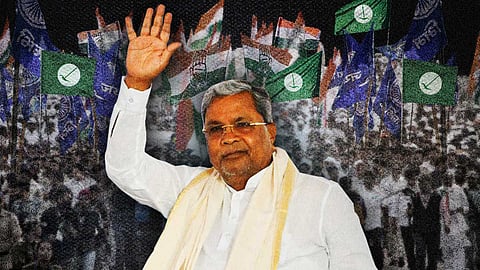The complex legacy of Siddaramaiah: A political and ideological profile
The thousands of disparate communities lumped together into categories of Scheduled Caste (SC), Scheduled Tribe (ST), Other Backward Classes (OBC) as well as religious minorities in India have a shared history of exploitation and a common oppressor. But the structure that exploits them is also designed to trap them in an endless, and often murderous, competition with one another. They are rivals as much as they are comrades.
This reality of Indian politics is a useful framework to understand the complex legacy of Karnataka Chief Minister Siddaramaiah and his politics of AHINDA — a Kannada acronym for Alpasankhyataru (minorities), Hindulidavaru (backward classes), Dalitaru (Dalits). It was coined in the 1970s by the legendary socialist leader and former Karnataka Chief Minister D Devaraj Urs.
The state’s most powerful socialist leader after Urs, Siddaramaiah’s career has been marked by the intense rivalry between different communities within the AHINDA fold. Dealing with these competing interests has defined his politics, earning him both bouquets and brickbats along the way.
As we take a closer look at the intricate balance between the pragmatism required to retain power and the ideological convictions he championed, we begin to get a sense of what it takes to be a mass leader when the masses are divided over caste and religion.
With the exception of Brahmin CMs like Gundu Rao and Ramakrishna Hegde, every CM of Karnataka has been from the OBC category. Yet, an overwhelming majority of them are remembered as either Vokkaliga or Lingayat leaders who used their powerful caste base as a foundation to build clever electoral coalitions.
Devaraj Urs and Siddaramaiah, and to a lesser degree S Bangarappa and M Veerappa Moily, are the only exceptions in this list. What sets leaders like Devaraj Urs and Siddaramaiah apart is the fact that all of them managed to break out of the Vokkaliga-Lingayat binary of Karnataka politics and form a powerful coalition of the most marginalised social groups. Importantly, they managed to make the most of the ‘intersectionality’ of the people within the AHINDA formation and bring them together despite their differences.
At a time when a land scam allegedly involving his wife and her family is threatening to end Siddaramaiah’s career prematurely, his supporters are up in arms saying his exit will sound the death knell for social justice politics in Karnataka.
This refrain calls for a deeper analysis of the last four decades during which Siddaramaiah has loomed large over the state’s politics. How did a man who won his first MLA election in 1983 on a ticket from the Bharatiya Lok Dal come to represent the aspirations of the weakest sections of society?
An agitation he didn’t endorse
Life was just about limping back to normal after the first COVID-19 lockdown in late 2020 when Karnataka’s third largest caste group, the Kurubas, launched a major agitation saying they had been wrongly classified as OBC. The Kurubas, who have traditionally been shepherds and pastoralists, wanted to be shifted to the ST list alongside forest dwelling communities such as Jenu Kurubas and Kadu Kurubas of Karnataka. They claimed to be tied to these tribes and with the Gond adivasis of central India through kinship.

